Skip to content

Welcome to Terlingua Cemetery, in Terlingua Texas.
 To those who are more accustomed to manicured cemeteries with vast green lawns, this place appears to be abandoned, but Terlingua cemetery is still in use today.
To those who are more accustomed to manicured cemeteries with vast green lawns, this place appears to be abandoned, but Terlingua cemetery is still in use today.
It’s one of the most photographed graveyards in the state of Texas, which should come as no surprise.
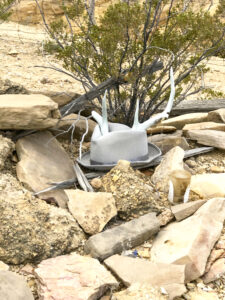 I’ve wanted to visit this amazing burial ground since I was a child, so to have the opportunity to roam through it – left alone with my thoughts and wonder about those who rest here – was a true privilege. There are the well-known, the unknown and the surprise of finding the grave of someone I knew personally in college. It was an astounding experience.
I’ve wanted to visit this amazing burial ground since I was a child, so to have the opportunity to roam through it – left alone with my thoughts and wonder about those who rest here – was a true privilege. There are the well-known, the unknown and the surprise of finding the grave of someone I knew personally in college. It was an astounding experience.
Terlingua was one of the most remote areas in North America at the time it was founded. It still remains set apart from more populated areas.
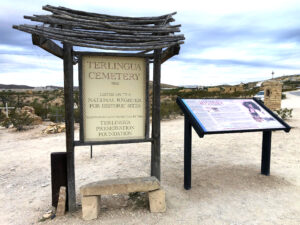 The cemetery encompasses one acre in the Terlingua Ghost Town – which isn’t really a ghost town at all. True . . . the town used to be the site of a quicksilver mining camp and place where desert folk called home beginning in the 1880s, but it’s now more of an artist community and a low key tourist base for visiting Big Bend National Park.
The cemetery encompasses one acre in the Terlingua Ghost Town – which isn’t really a ghost town at all. True . . . the town used to be the site of a quicksilver mining camp and place where desert folk called home beginning in the 1880s, but it’s now more of an artist community and a low key tourist base for visiting Big Bend National Park.
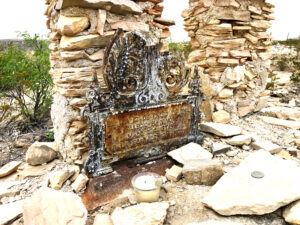 Marked graves date back to 1903, but burials began back when the dangerous process of mercury mining began here. Mine collapses, mercury poisoning and later influeza and tuberculosis epidemics populated the cemetery.
Marked graves date back to 1903, but burials began back when the dangerous process of mercury mining began here. Mine collapses, mercury poisoning and later influeza and tuberculosis epidemics populated the cemetery.
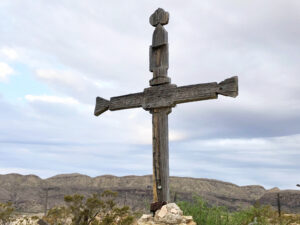 Conservative estimates say that there are about 400 burials in the cemetery: Men, women, and children. Miners, goat herders, artists, housewives, ranch hands, cooks, bootleggers, day laborers, war veterans, clergy, even murder victims. About 90 percent of those who rest here are of Hispanic heritage.
Conservative estimates say that there are about 400 burials in the cemetery: Men, women, and children. Miners, goat herders, artists, housewives, ranch hands, cooks, bootleggers, day laborers, war veterans, clergy, even murder victims. About 90 percent of those who rest here are of Hispanic heritage.
Those that were victims of mining accidents were sometimes laid to rest in coffins made by the companies they worked for.
Many of the gravesites have lost their markers, or they have simply become illegible over time. Some have all but vanished due to relentless weather and relic hunters.
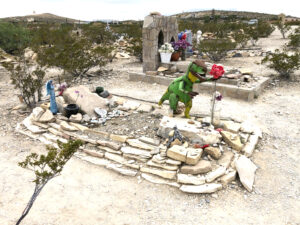 Others reflect the character and sometimes humor of those who they remember. A Hobbit hole, a metal T-Rex, and epitaph of “Another good man done gone.” They all lure visitors into slowing down to take in the silent stories of the cemetery.
Others reflect the character and sometimes humor of those who they remember. A Hobbit hole, a metal T-Rex, and epitaph of “Another good man done gone.” They all lure visitors into slowing down to take in the silent stories of the cemetery.
The Mining town was abandoned in the 1940s. That’s when Terlingua became a true ghost town . . . years before it became home to artists and others who tired of life in overcrowded communities . . . and eventually the visits of countless curious tourists on their way to Big Bend.
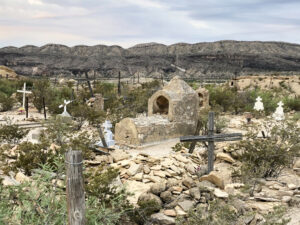 Visitors are fascinated by the variety of burial markers and folk art memorials, and of course – the stunning View of Chisos Mountains and Sierra del Carmens as a backdrop.
Visitors are fascinated by the variety of burial markers and folk art memorials, and of course – the stunning View of Chisos Mountains and Sierra del Carmens as a backdrop.
Each year an elaborate celebration takes place here to mark Dia de los Muertos, or Day of the Dead, giving the living a chance to honor and remember the departed.
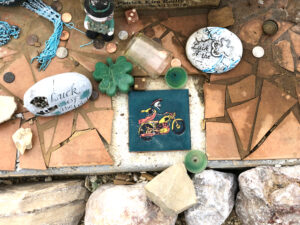
Walking into Terlingua cemetery is like walking into a time warp. If a visit to this fascinating place doesn’t make a person stop and reflect . . . I’m not sure what would.

Join me for a stroll through the grounds of this historic cemetery in my Youtube video of the cemetery HERE.
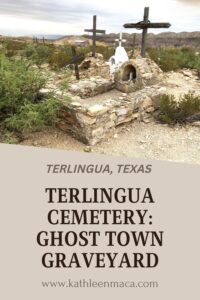
Driving through Central Texas recently, I made a detour to visit a Fairy . . . and the tiny town named after her.
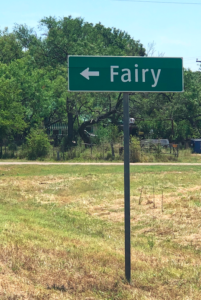
In a state that likes to brag that “bigger is better,” the town of Fairy Texas in Hamilton County named themselves after a surprisingly diminutive member of their community.
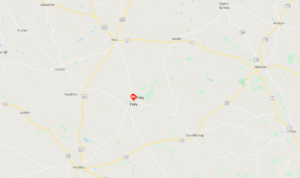 Originally known as Martin’s Gap it was named after James Martin, a settler killed by local Indians in the 1860s while driving cattle through a “gap” between two mountains in the area. He was buried at the foot of one of those mountains.
Originally known as Martin’s Gap it was named after James Martin, a settler killed by local Indians in the 1860s while driving cattle through a “gap” between two mountains in the area. He was buried at the foot of one of those mountains.
As you can see from the map, it isn’t “on the way” to anywhere particularly…but it’s worth a road trip diversion.
When a post office was requested for the town in 1884, locals renamed it “Fairy” to honor Fairy Fort Phelps (1865-1938), the daughter of Sallie and Battle Fort, a former Confederate Army Captain and lawyer.
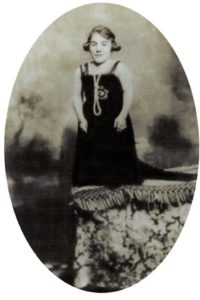
One of the smallest Texans ever, Fairy was just 2’ 7” tall and weighed about 28 pounds. Her size didn’t stop her from leading a somewhat normal life and becoming one of the most beloved people in her community.
Her namesake town once had a cotton gin, school, general store, café and businesses to serve the ranchers in the area.
Fairy had four younger brothers: Henry; Hugh Franklin; William “Battle,” Jr; and Walter Herbert – all of whom were average heights.
Fairy and her father taught area children at a school in their home for many years. One story reflects how respected and well liked she was by her students. The tale states that it became necessary for Fairy to paddle an unruly student, but she couldn’t high enough. The student himself lifted his teacher onto a chair so she could paddle him.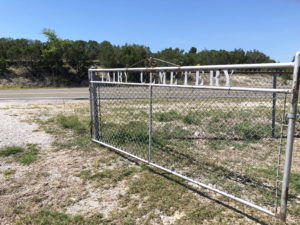
The petite young lady even married twice, once to William Y. Allen in 1892 and again to T. J. Phelps in 1905, but both marriages ended in divorce. Probably not surprisingly, she never had children, but she did live into her 70s and is buried with her parents at…yes…Fairy Cemetery. The sign on the gate alone is enough to back you look twice.
Fairy’s post office closed in 1947, and the school consolidated with Hamilton schools in 1967. A Baptist church, community center, volunteer fire department, a few homes and one historic cemetery are all that endure.
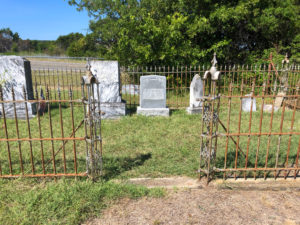
The stories of a petite woman who lived life to the fullest remain with the residents, and those who stop to visit her gated grave.
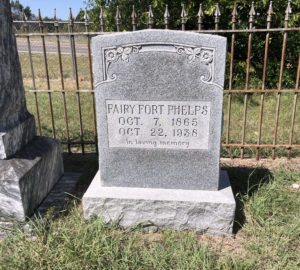
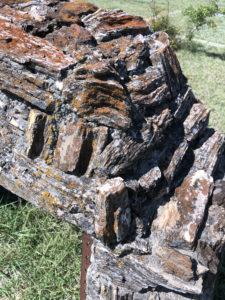 The tiny town’s cemetery is interesting on its own for a variety of style of distinctive, handmade grave markers. Many exhibit expert stone carving skills, but others include one constructed of petrified wood and another meticulously covered with sparkling, local minerals.
The tiny town’s cemetery is interesting on its own for a variety of style of distinctive, handmade grave markers. Many exhibit expert stone carving skills, but others include one constructed of petrified wood and another meticulously covered with sparkling, local minerals.
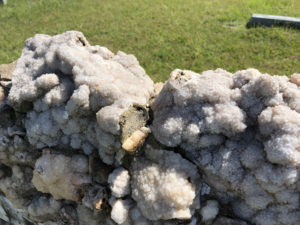
Oh….and if you’re curious what locals are called, they are “Fairians.” How cute is that?
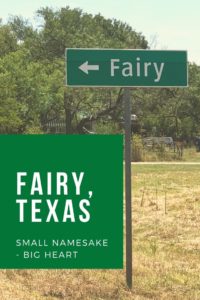
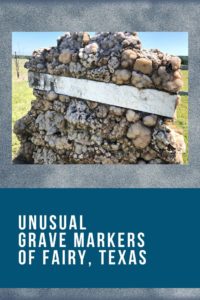
Having wandered through countless cemeteries in the past forty years, I can easily recognize most of the common iconography or symbolism used to decorate the markers. That makes it especially exciting to see something new (to me).
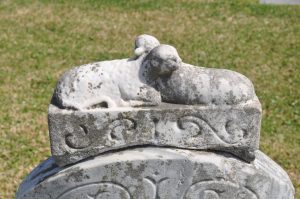
This unusual marker in Galveston’s Calvary Catholic Cemetery features two lambs resting their heads together, marking the grave of two siblings, each of whose inscriptions is featured on opposite sides of a double-sided stone.
Happily the children’s names are on the stone. So many markers of this type only identify small children as “Son of” or “dau. of” and give the parents initials or names. Their parents remain a mystery however, for the same reason.

Nellie
“Angel”
Born June 29, 1888 and died Sept. 30, 1888.
Dearest loved one, we have laid thee
in the peaceful grave’s embrace,
but thy memory will be cherished
till we see thy heavenly face.
Almost exactly one year after their daughter’s death, a son was born to the couple. But that joy was short-lived as well.
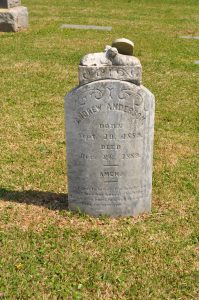
Andrew
“Amen”
Sept. 10, 1889 and died Dec. 26, 1889
‘Tis hard to break the tender cord
When love has bound the heart
‘Tis hard so hard, so speak the words
Must we forever part
Losing a child so close to Christmas always seems especially poignant.
There are almost two full pages of Andersons in the local directory during this time period, and unfortunately no further clues as to the identity of the parents at this time. Looking for other Andersons in the same cemetery failed to provide more leads as well due to the number of seemingly unrelated individuals with that surname.
Both of the children were just three months old. I wonder if the couple had any more children who survived, but likely will never know.
Although I occasionally run across a rare exception, lambs on gravestones denote the resting place of children and symbolize purity and innocence. This symbolic use of the lamb pre-dates Christianity, being used first by the Egyptians.
Many lamb figures on grave markers from this time period are missing their heads, or so severely eroded that they appear more like a lump than a small animal. This one is lucky, perhaps because of the strength of their necks resting against each other, to still be intact.
I wonder if there are any family members left on the island to visit this poignant remembrance.

 To those who are more accustomed to manicured cemeteries with vast green lawns, this place appears to be abandoned, but Terlingua cemetery is still in use today.
To those who are more accustomed to manicured cemeteries with vast green lawns, this place appears to be abandoned, but Terlingua cemetery is still in use today.
 I’ve wanted to visit this amazing burial ground since I was a child, so to have the opportunity to roam through it – left alone with my thoughts and wonder about those who rest here – was a true privilege. There are the well-known, the unknown and the surprise of finding the grave of someone I knew personally in college. It was an astounding experience.
I’ve wanted to visit this amazing burial ground since I was a child, so to have the opportunity to roam through it – left alone with my thoughts and wonder about those who rest here – was a true privilege. There are the well-known, the unknown and the surprise of finding the grave of someone I knew personally in college. It was an astounding experience. The cemetery encompasses one acre in the Terlingua Ghost Town – which isn’t really a ghost town at all. True . . . the town used to be the site of a quicksilver mining camp and place where desert folk called home beginning in the 1880s, but it’s now more of an artist community and a low key tourist base for visiting Big Bend National Park.
The cemetery encompasses one acre in the Terlingua Ghost Town – which isn’t really a ghost town at all. True . . . the town used to be the site of a quicksilver mining camp and place where desert folk called home beginning in the 1880s, but it’s now more of an artist community and a low key tourist base for visiting Big Bend National Park. Marked graves date back to 1903, but burials began back when the dangerous process of mercury mining began here. Mine collapses, mercury poisoning and later influeza and tuberculosis epidemics populated the cemetery.
Marked graves date back to 1903, but burials began back when the dangerous process of mercury mining began here. Mine collapses, mercury poisoning and later influeza and tuberculosis epidemics populated the cemetery. Conservative estimates say that there are about 400 burials in the cemetery: Men, women, and children. Miners, goat herders, artists, housewives, ranch hands, cooks, bootleggers, day laborers, war veterans, clergy, even murder victims. About 90 percent of those who rest here are of Hispanic heritage.
Conservative estimates say that there are about 400 burials in the cemetery: Men, women, and children. Miners, goat herders, artists, housewives, ranch hands, cooks, bootleggers, day laborers, war veterans, clergy, even murder victims. About 90 percent of those who rest here are of Hispanic heritage. Others reflect the character and sometimes humor of those who they remember. A Hobbit hole, a metal T-Rex, and epitaph of “Another good man done gone.” They all lure visitors into slowing down to take in the silent stories of the cemetery.
Others reflect the character and sometimes humor of those who they remember. A Hobbit hole, a metal T-Rex, and epitaph of “Another good man done gone.” They all lure visitors into slowing down to take in the silent stories of the cemetery. Visitors are fascinated by the variety of burial markers and folk art memorials, and of course – the stunning View of Chisos Mountains and Sierra del Carmens as a backdrop.
Visitors are fascinated by the variety of burial markers and folk art memorials, and of course – the stunning View of Chisos Mountains and Sierra del Carmens as a backdrop.
















